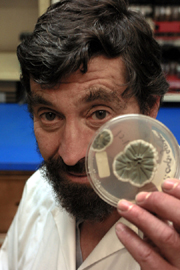
 |

|
|
 |
|
|
|||
 Biology Professor Paul Widden with penicilium chrysogenum, a common fungus that lives in the soil (and sometimes in your fridge). It gave rise to the “miracle drug” penicillin. Photo by Andrew Dobrowolskyj |
by Sylvain Comeau Forests are a rich environment for a variety of fungal life forms. Unfortunately, so are many of the buildings in which we live and work. According to Biology Professor Paul Widden, that fact is one of the reasons for sick building syndrome. “The variety of fungi that you see in buildings just reflects the variety that grows in the natural environment. Any fungus that can grow outside will be found inside sooner or later, and some of them are very toxic, like Stachybotrys, which produces nasty toxins and which has proven fatal to some people, especially infants.” Widden cited an infamous rash of infant deaths caused by Stachybotrys in several U.S. households. Professor Widden works with Natur/Air, a company that conducts building inspections and sends samples to Widden for analysis in his lab. He was approached to do that work because of his research interest in the communities of fungi that live in soil. These serve the purpose of decomposing dead leaves and twigs, but are less benign when found in high concentrations where people live or work. Widden said that there has been an explosion of concern and awareness of the threat that moulds in buildings can pose, thanks to highly publicized health problems like those in the Royal Victoria Hospital. “Ten or 15 years ago, people were hardly aware of the problem of moulds in a building; now they see a stain and they get worried. That changes the response I get from building administrators, for example, who used to dismiss the possibility of a mould problem.” While awareness has improved, Widden said that the problem is only getting worse in recent years because of changes in building design. “In the 1960s and 70s, we became very concerned about conserving energy. We started constructing large buildings that were sealed, where you could control everything from the inside — humidity and temperature — and filter out fungal spores. But engineers did not understand biology at all, how microbes grow and their requirements for growth. “The first North American building engineering conference to even include microbes on its agenda was in 1992.” Newer buildings most toxic Ironically, newer buildings might harbour the worst toxic growth of fungus and mould. “In sealed buildings, you can humidify air and push it through a filter, where there is a lot of dust and carbon. That’s a good environment for the growth of mould and bacteria. It gets into the ventilation, air conditioning and filtration systems. So some buildings have had problems because they are sealed, but an older building is leaky; it’s not airtight.” Widden’s work on sick buildings is a sideline to his research on mycorrhizal fungal communities, which are ubiquitous in ecosystems and have recently been shown to affect the competitive balance between plant species and the diversity of the ecosystem. This may lead to the development of agricultural and forestry applications. “In the forest, clear-cutting can harm mycorrhizal systems. In agriculture, there are many practices that might deter the growth of these systems, such as deep plowing, overuse of fertilizers, and fungicides.” Fungicides, for example, are used to prevent harmful fungi from attacking crops, but they can have the opposite effect if they destroy some beneficial fungi. “Some fungi prevent trees or crops from being attacked by pathogens; so if you disrupt that mycorrhizal system, that may leave them vulnerable. “It is like the overuse of antibiotics. We have a bacterial flora in our guts and on our skins that protect us from infection. If you give antibiotics to healthy people, they tend to get sick, because they have lost that protection. Using fungicides as a preventative measure is the same thing, and just invites problems. “A better understanding of how mycorrhizal systems work can lead to agricultural or forestry practices which will take advantage of these natural systems, rather than working against them.” |